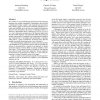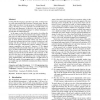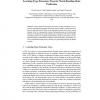43 search results - page 6 / 9 » A Typed, Compositional Logic for a Stack-Based Abstract Mach... |
EFDBS
2003
13 years 8 months ago
2003
A definition of types in an information system is given from ld abstractions through data constructs, schema and definitions to physical data values. Category theory suggests tha...
TLDI
2010
ACM
14 years 4 months ago
2010
ACM
ML modules are a powerful language mechanism for decomposing programs into reusable components. Unfortunately, they also have a reputation for being “complex” and requiring fa...
ML
2006
ACM
14 years 1 months ago
2006
ACM
Existing ML-like languages guarantee type-safety, ensuring memty and protecting the invariants of abstract types, but only within single executions of single programs. Distributed...
ICFEM
2010
Springer
13 years 6 months ago
2010
Springer
Abstract. Today’s software systems are becoming increasingly configurable and designed for deployment on a plethora of architectures, ranging from sequential machines via multic...
ML
2011
ACM
13 years 1 months ago
2011
ACM
Abstract. Type Extension Trees (TET) have been recently introduced as an expressive representation language allowing to encode complex combinatorial features of relational entities...



